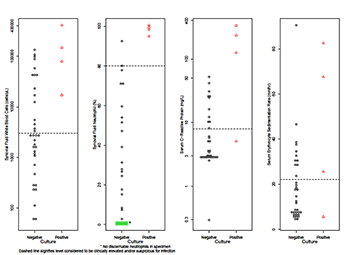Diagnosing Infection in Failed Metal-on-Metal Hip Arthroplasty: Are Synovial Fluid Aspirations Helpful?
Authors: Wyles CC, Larson DR, Houdek MT, Sierra RJ, Trousdale RT, Mayo Clinic Rochester, MN
Title: Diagnosing Infection in Failed Metal-on-Metal Hip Arthroplasty: Are Synovial Fluid Aspirations Helpful?
Background: Currently, white blood cell (WBC) count and neutrophil percentage from preoperative synovial fluid aspirations are used to help determine the presence or absence of periprosthetic joint infection (PJI) in failed total hip arthroplasty (THA). The clinical levels indicative of infection are not well delineated in the prosthetic hip and especially between different types of bearing surfaces. We are unaware of any data comparing typical ranges of synovial fluid WBC count and neutrophil percentage in culture positive vs. culture negative failed metal-on-metal (MoM) THA.
Hypothesis/Purpose: What is the sensitivity and specificity of synovial fluid white blood cell count and neutrophil percentage in diagnosing infection in failed MoM THA?
Methods: We reviewed all patients receiving revision of a primary MoM THA at our institution between August 2006 and March 2012. From this cohort, 39 cases in 38 patients were identified that received a preoperative synovial fluid aspiration prior to revision of their implant. Data was collected preoperatively for aspiration WBC count and neutrophil percentage, erythrocyte sedimentation rate (ESR), C-reactive protein (CRP), serum cobalt and chromium, age, gender, reason for revision, and for culture results of intraoperative specimens.
Results: 35/39 cases were culture negative and 4/39 were culture positive for strains of methicillin-resistant staphylococcus aureus (N=2), viridans group streptococcus (N=1), and group G streptococcus (N=1). While WBC count was 100% sensitive but only 57.1% specific (> 3,000 cells/microliter), neutrophil percentage was 100% sensitive and 97.1% specific (> 80%). Both CRP and ESR were 75.0% sensitive and 67.6% specific (> 8.0 mg/L and > 22 mm/hr, respectively).
Discussion: Our data suggests that synovial fluid WBC counts as well as serum ESR and CRP have poor predictive value in diagnosing PJI for failed MoM THA. Conversely, we have demonstrated that neutrophil percentage is a highly accurate marker for diagnosing infection in this patient population. When looking at synovial fluid aspirations, the neutrophil percentage should take precedence over the WBC count as a data point for diagnosing PJI.
Conclusion: Synovial fluid white blood cell counts are variable and often misleading when diagnosing an infection in failed MoM THA, whereas neutrophil percentages are a highly accurate marker.

